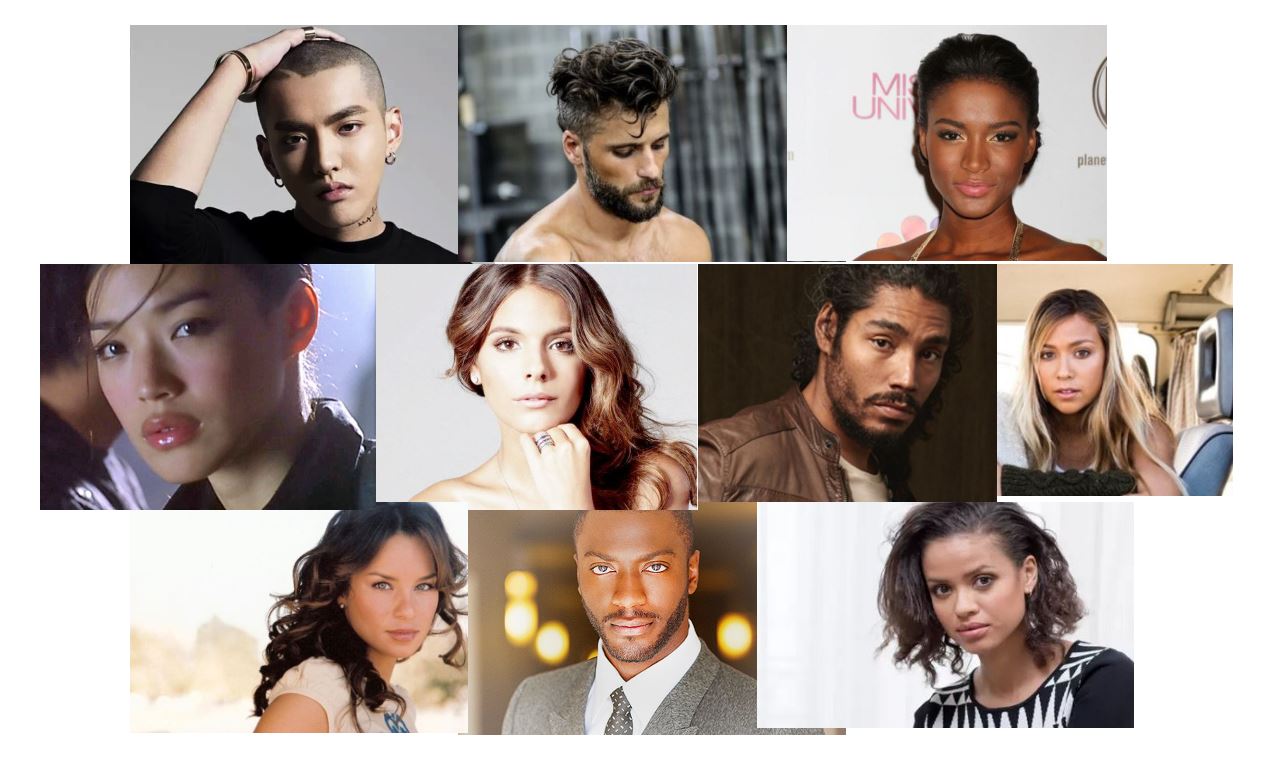
Right to Left/Top to Bottom: Wu Lifan, Bruno Gagliasso, Leila Lopes, Shu Qi, Caitlin Stasey, Diogo Sales, Tia Blanco, Nicole Lyn, Aldis Hodges, Gugu Mbatha All credit to original photographers, used under Fair Use laws.
Fancasting… it’s often see as something writers do to avoid actually writing. It’s treated like a stall tactic. But, if you want a diverse cast and want diversity in your books, it’s actually good way to get a headcount of what diversity is available.
The fancast above is for my FREE FALL universe. The guy top-center is the main characters, and everyone else is either a direct relative, related by marriage, or a member of his crew. This lets me see skin tone. Is everyone getting some rep in a universe where Earth is a distant memory and races have intermingled and changed and there are very few single-skin-tone groups any more?
On the profile I have on my computer I also have markers for disability (two with physical disabilities, several with PTSD or other mental health issues), sexuality (demisexual, pan, and het are all in the mix), genders, and ages (although they all look similar here there is an age range from early 20’s to late 40’s because the previous generation was killed in war).
HOW TO USE THIS IN WRITING?
- Make a fancast. Google and Tumblr are your friend. Find faces that fit your characters.
- Do a once over and see if you need to maybe change the description. I started with one of the women having lighter skin and realized that left an imbalance that didn’t make sense. I changed the description and the fancast.
- Tag your characters by major diversity labels that might apply.
- Make changes where you need to.
NOTE: Humans are more likely to hang out with people like them. Gay people hang out with gay people. White people hang out with white people. Third Culture Kids find other Third Culture Kids. We all like being with people like us. So, if you have a range of differences, explain why. Do they work together? Are they family? Do they go to school together? Diversity needs to be intentional. If you throw a bunch of different people together with no explanation and no common ground it will feel forced, and that’s not good.
Can my book be all about one gender/race/sexuality?
Sure! That’s a thing that happens. Just acknowledge why you’re making the choice. If you’re writing an entire world with white skin and pale hair… why? What genetic twist made these humans mutate from the default of brown hair/skin/eyes? Why does everyone have the same sexuality?
If you’re writing a book about three girls at school in rural Illinois on an afternoon trip to the lake the lack of diversity is going to be less noticeable than it would be if you had a larger cast.
General rule of thumb? The more people you have, the more diversity you’ll see in the book.
Can I write a label that isn’t my own?
Yes! But do your research and be respectful. Not just in terms of letting someone different from you be a flawless goddess on the page, but respect which stories are free for everyone and which stories belong specifically to a culture. It’s very hard for an abled person to write what it’s like to live with a disability. A heterosexual is not the best person to write a story about someone coming out as homosexual. A white person shouldn’t be writing about contemporary black culture in America.
BUT! You don’t need to center the story on the labels. Having a pansexual does not mean the story is automatically about their sexuality. You can write someone with a different skin tone than you without the story being about their skin color. Writing diversity includes letting everyone see themselves as everything. As the space captain, as the rogue, as the villain, as the hero, as the love interest, as the guard, as the heiress, as the dragon, as the all-knowing sage, and as the comic relief.
What if I’m nervous about writing people who don’t look/think like me?
Go read a book. Go find a book by someone similar to the person you want to write. Read many, many books where they describe people like themselves and the world around them. Listen. Learn. Watch how they do it, and how their culture describes things, and then make sure you have someone from that community check your idea and manuscript before you push it out into the world.
There are a multitude of resources online that discuss which stories are appropriate and which have crossed a line. Go research for yourself before asking someone (especially from a minority community) to do the emotional labor of educating you on what’s appropriate. Make sure you aren’t using stereotypes. Don’t rely on movies for your research. Don’t use third-party resources (a white person writing about Rroma probably is going to do a terrible job).
Are there any major pitfalls to avoid?
- don’t make all the dark-skinned people evil
- don’t make all the gays cheerful/silly/fashionable
- don’t describe all people of a single race/skin tone as being hypersexual/submissive/aggressive/uneducated/ect
- don’t be a dick
And, as always, read widely in the genre you’re writing.
See how other people are doing it. Get a feel for what’s acceptable. Personally, I think SF has more wiggle room when it comes to diversity. Not that we can get away with writing diversity poorly, but the diversity in SF has been part of the genre for decades and people are more willing to accept descriptions that are not tied to a real culture in ways they wouldn’t with a contemporary piece. Other people may disagree. I have a noticeable bias. 🙂


